Intel Unveils New Low-Cost PC Platform: Apollo Lake with 14nm Goldmont Cores
by Anton Shilov on April 15, 2016 6:00 PM EST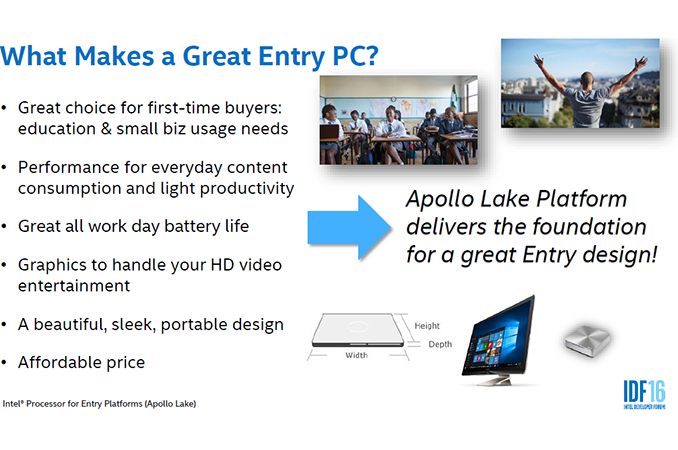
This week, at IDF Shenzhen, Intel has formally introduced its Apollo Lake platform for the next generation of Atom-based notebook SoCs. The platform will feature a new x86 microarchitecture as well as a new-generation graphics core for increased performance. Intel’s Apollo Lake is aimed at affordable all-in-ones, miniature PCs, hybrid devices, notebooks and tablet PCs in the second half of this year.
The Apollo Lake system-on-chips for PCs are based on the new Atom-based x86 microarchitecture, named Goldmont, as well as a new graphics core that features Intel’s ninth-generation architecture (Gen9) which is currently used in Skylake processors. Intel claims that due to microarchitectural enhancements the new SoCs will be faster in general-purpose tasks, but at this stage Intel has not quantified the improvements. The new graphics core is listed as being more powerful (most likely due to both better architecture and a higher count of execution units), but will also integrate more codecs, enabling hardware-accelerated playback of 4K video from hardware decoding of HEVC and VP9 codecs. The SoCs will support dual-channel DDR4, DDR3L and LPDDR3/4 memory, which will help PC makers to choose DRAM based on performance and costs. As for storage, the Apollo Lake will support traditional SATA drives, PCIe x4 drives and eMMC 5.0 options to appeal to all types of form-factors. When it comes to I/O, Intel proposes to use USB Type-C along with wireless technologies with Apollo Lake-powered systems.
| Comparison of Intel's Entry-Level PC and Tablet Platforms | ||||||
| Bay Trail | Braswell | Cherry Trail | Apollo Lake | |||
| Microarchitecture | Silvermont | Airmont | Airmont | Goldmont | ||
| SoC Code-Name | Valleyview | Braswell | Cherryview | unknown | ||
| Core Count | Up to 4 | |||||
| Graphics Architecture | Gen 7 | Gen8 | Gen8 | Gen9 | ||
| EU Count | unknown | 16 | 12/16 | unknown (24?) | ||
| Multimedia Codecs | MPEG-2 MPEG-4 AVC VC-1 WMV9 HEVC (software only) VP9 (software only) |
MPEG-2 MPEG-4 AVC VC-1 WMV9 HEVC (8-bit software/hybrid) VP9 (software/hybrid) |
MPEG-2 MPEG-4 AVC VC-1 WMV9 HEVC VP9 |
|||
| Process Technology | 22 nm | 14 nm | 14 nm | 14 nm | ||
| Launch | Q1 2014 | H1 2015 | 2015 | H2 2016 | ||
From the IDF presentation, Intel shares only a few brief details regarding its new Apollo Lake design platform, but does not disclose exact specifications or performance numbers. At this point, based on 14nm Airmont designs, it is pretty safe to assume that the new SoCs will contain up to four Goldmont cores in consumer devices but perhaps 8+ in communications and embedded systems. Intel has not specified the TDP of its new processors but claims that power management features of the platform will help it to improve battery life compared to previous-gen systems (which might point to a Speed Shift like arrangement similar to what we see on Skylake, perhaps). While Intel does not reveal specifics of its own SoCs, the company shares its vision for the upcoming PCs powered by the Apollo Lake platform.
Firstly, Intel believes that the upcoming affordable PCs, whether these are all-in-one desktops, miniature systems, 2-in-1 hybrids, laptops or tablets, should be very thin. According to their market research, this will make the devices more attractive to the buyer, which is important. To make systems thinner, Intel traditionally proposes to use either M.2 or solder-down eMMC solid-state storage options instead of 2.5” HDDs/SSDs. In addition, the company believes that it makes sense to use solder-down Wi-Fi, instead of using a separate module. Intel seems to be especially proud with the compactness of the Apollo Lake SoC (as well as other core components) and thus the whole platform, which is another factor that will help to make upcoming systems thinner. For the first time in recent years, Intel also proposes the use of smaller batteries, but devices can maintain long battery life by cutting the power consumption of the entire platform. While in many cases reduction of battery size makes sense, it should be noted that high-resolution displays typically consume a lot of energy, which is why it is hard to reduce the size of batteries, but maintain the visual experience along with a long battery life.
Secondly, PCs based on the Apollo Lake should be very affordable, which is why Intel’s reference core components design can be used for different form-factors (AiO and mobile). Additionally, the company reveals a number of BOM (bill of materials) savings opportunities, which are a result of higher level of SoC integration as well as a recommended choice of components. In the slide above, using all the savings can make a difference in BOM for between $5.55 and $7.35, which could mean double memory or a better display for the same price for the new generation.
Intel’s reference design for Apollo Lake-based PCs seems to be a tablet/2-in-1 hybrid system with an 11.6” full-HD (1920x1080) 10-point multi-touch display, 4 GB of LPDDR3-1866 memory, 64 GB M.2 SATA3 SSD or 32 GB eMMC storage, an M.2 wireless module supporting 802.11ac, an optional M.2 LTE modem, an integrated USB 2 camera, a host of sensors (accelerometer, ambient light, proximity detection, and magnetic switching) as well as a USB Type-C connector supporting USB power delivery and alternate modes. Such reference design can power not only mobile, but also Aan IO and even small form-factor desktop PCs. Still, given the fact that we are talking about low-cost systems, do not expect retail computers to feature multiple storage devices and LTE modems. However, PC makers may opt for more advanced displays as well as better integrated cameras, or an SI might plump for a half-price 'Macbook-like' device design using Type-C, albeit on the Atom microarchitecture. This is Intel's vision forthe next generation of Chromebooks: the 'cloud book' market.
PCs based on Intel’s Apollo Lake platforms will emerge in the second half of the year and will carry Celeron and Pentium-branded processors. At present, entry-level notebooks (which Intel calls Cloudbooks) offer 2 GB of memory, 32 GB of storage, 8+ hours of battery life and ~18mm thick designs. With Apollo Lake, OEMs should be able to increase the amount of RAM and/or storage capacity, make systems generally thinner, but maintain their $169 - $269 price-points. Intel also believes that its Apollo Lake presents great opportunities to build 2-in-1 hybrid PCs (convertibles) and capitalize on higher margins of such systems.
Traditionally, Intel discusses options and its vision, but not actual PCs, at its IDF trade-shows. It remains to be seen whether PC makers decide to build low-cost convertibles or ultra-thin notebook designs, or will stick to more traditional clamshell notebooks. In fact, we will learn more about BTS (back-to-school) plans of major PC OEMs regarding Apollo Lake at the upcoming Computex trade-show in early June. There's also IDF San Francisco in August where Intel may open some lids on how the new Goldmont core differs from Airmont.
Source: Intel


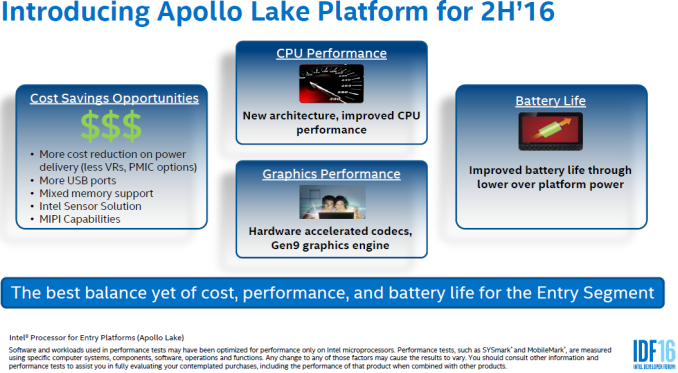
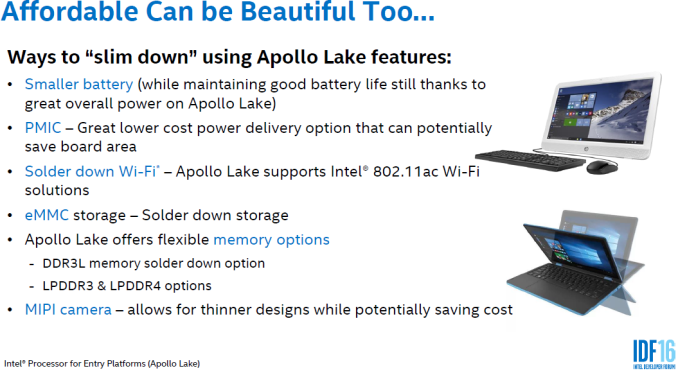
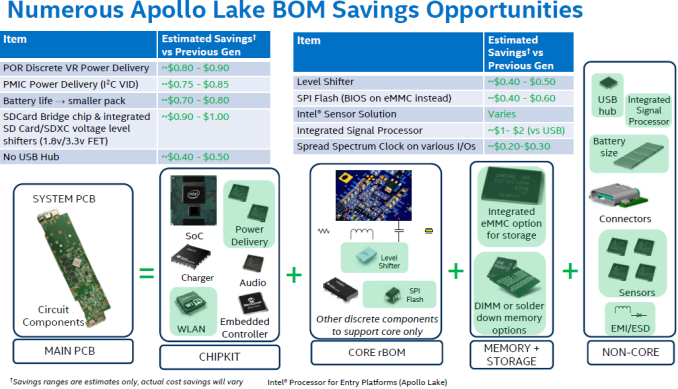
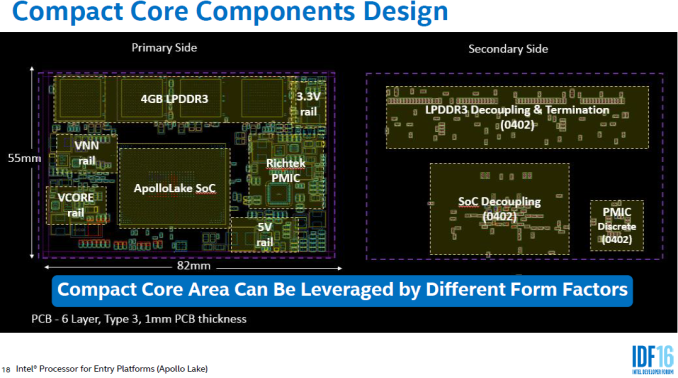
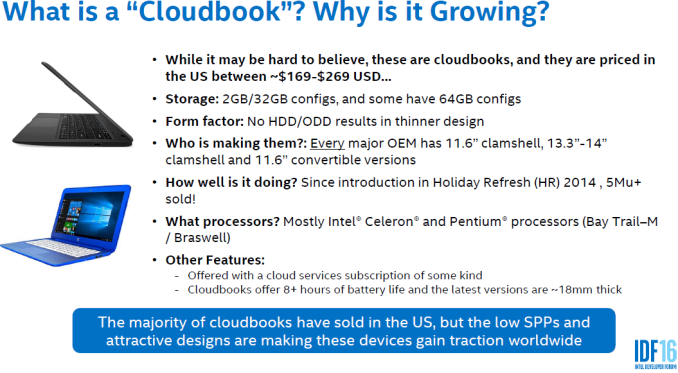
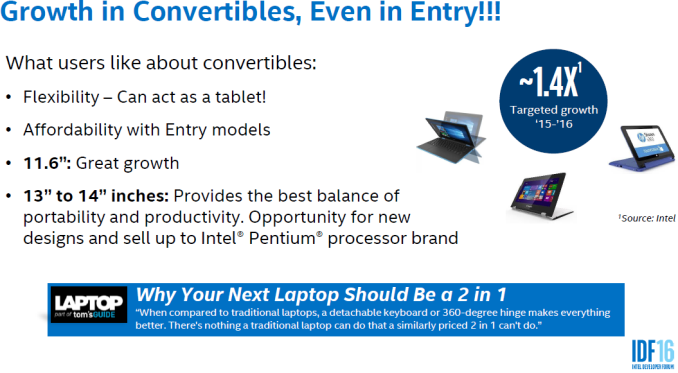














95 Comments
View All Comments
eddman - Sunday, April 17, 2016 - link
What's the DMIPS of apple's A9? Aren't ARM processors still way behind intel's when it comes to FP calculations?name99 - Monday, April 18, 2016 - link
iPad Pro vs Surface Pro 4:http://browser.primatelabs.com/geekbench3/compare/...
The single-threaded numbers are ridiculously comparable --- about as many wins for Intel as for Apple. (And that includes FP.)
Obviously Intel comes out slightly ahead in multi-core because of hyper-threading, but that's simply not very interesting --- if Apple cared about multi-core performance their easy solution (maybe not always, but certainly for now) but would be to simply slap a third core onto the die, like they did for the A8X. The cores are small enough that that would increase die area by no more than maybe 6% or so.
The GPU numbers are even more stark, with iPad Pro substantially ahead of Surface Pro.
Speedfriend - Monday, April 18, 2016 - link
@name99try
Kraken Surface Pro i5 1179 v iPad Pro 1535
Octane 30,064 v 19,862
WebPRT 326 v 221
IceStorm Physics 40,480 v 15,035
IceStorm Graphics 72,m183 v 50,240
IceStorm overall 61,482 v 33.046
IPad Pro is not even close in almost every benchmark....
name99 - Monday, April 18, 2016 - link
The numbers you give refer to an i5 CPU. I specifically said that A9 beat m-class (~5W, about the same as the Apple target power) x86.If you allow the Intel core substantially more power (~15W) then things change. No surprise there.
The Geekbench numbers, while obviously not perfect, have the advantage that for the most part it's CPU against CPU. The browser numbers are problematic for such an analysis because now you're also comparing across very different algorithms (up to and including possible multiple core use, where hyper-threading kicks in). Browser comparisons within the same browser (say Chrome to Chrome, or Safari to Safari) likely give some useful info, but across browser comparisons, while telling you something about the user experience, are not helpful for comparing cores.
IceStorm Physics, of course, is basically a test of frequency*number of cores. It's the DMIPS or Whetstone of graphics benchmarking --- utterly useless for providing new information.
What would be most useful (and what is missing) would be SPEC numbers using the same compiler. Unfortunately these don't yet exist, because the x86 numbers (that I have seen) have so far always been compiled with icc, which performs such aggressive (and apparently extremely code specific) transformations on SPEC that, once again, you're no longer comparing like with like. There were lots of complaints about this when the iPad Pro 12.9 review came out, so maybe we'll get lucky and have more comparable numbers (all done with LLVM, or at the very least x86 numbers done with gcc) when the detailed iPad Pro 9.7 numbers come out? Or maybe we'll have to wait until November and the A10 ;,-( ?
Meteor2 - Monday, April 18, 2016 - link
Normalised for power (15W v 5W), there's little difference in performance. But normalising is pointless -- there are simply no 15W ARM chips around, and none on the horizon. If it were easy, someone would've done it.rahvin - Tuesday, April 19, 2016 - link
TDP is measured differently by everyone and there is no reliable way to compare other than total system processing and power use. Attempting direct comparisons when they measure directly is an effort in futility.eddman - Tuesday, April 19, 2016 - link
That's not Dhrystone/DMIPS. Geekbench isn't exactly trusted when it comes to comparing ARM to x86.A Core i7 4770K's DMIPS per clock cycle, per core is 8.57. A cortex-A15's in an exynos 5250 is 3.5. What's A9's?
Same thing for FP numbers in geekbench.
KateH - Friday, April 15, 2016 - link
Re: the comparison chart- I'm 99% sure Bay Trail had 4EU's in the iGPU. Huge GFX performance increase going from Bay Trail to Cherry Trail with the extra transistor budget thanks to 14nm!varad - Friday, April 15, 2016 - link
I'm interested to see if this platform can show up in NUC sized boxes [for non-gaming HTPC apps]. The HW decode support for 4k HEVC + VP9 is great news. Is there any mention of whether there is support for HDMI 2.0 + HDCP 2.2 ?iwod - Friday, April 15, 2016 - link
Would really like a update on Atom performance. Are they still 1 Core 1 Thread? IPC improvement?Would a 4 Core Atom beat a 2 Core Sandy Bridge ( Which i consider to be the tipping point of CPU performance )
If not, how about a Core 2 Duo?